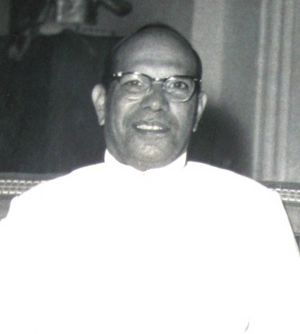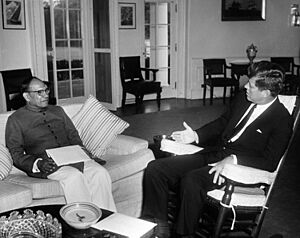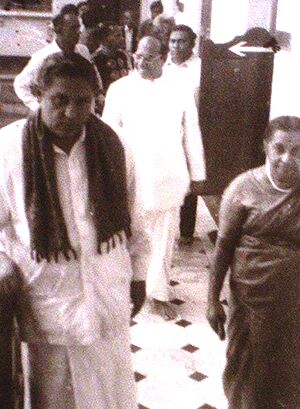William Gopallawa facts for kids
Quick facts for kids
William Gopallawa
|
|
|---|---|
|
|
 |
|
| 1st President of Sri Lanka | |
| In office 22 May 1972 – 4 February 1978 |
|
| Prime Minister | |
| Preceded by | Elizabeth II as Queen of Ceylon |
| Succeeded by | Junius Richard Jayewardene |
| 4th Governor-General of Ceylon | |
| In office 2 March 1962 – 22 May 1972 |
|
| Monarch | Elizabeth II |
| Prime Minister | |
| Preceded by | Sir Oliver Ernest Goonetilleke |
| Succeeded by | Position abolished (Himself as President of Sri Lanka) |
| 5th Secretary General of the Non-Aligned Movement | |
| In office 16 August 1976 – 4 February 1978 |
|
| Preceded by | Houari Boumédienne |
| Succeeded by | Junius Richard Jayawardene |
| Personal details | |
| Born | 17 September 1896 Matale, British Ceylon |
| Died | 31 January 1981 (aged 84) Colombo, Sri Lanka |
| Political party | Independent |
| Spouse |
Seelawathie Rambukwella
(m. 1928; died 1977) |
| Children | 5 |
| Alma mater |
|
William Gopallawa (born September 17, 1896 – died January 31, 1981) was an important leader in Sri Lanka's history. He was the last Governor-General of Ceylon from 1962 to 1972. When Ceylon became a republic in 1972 and changed its name to Sri Lanka, he became its first President of Sri Lanka.
Before 1972, Sri Lanka was known as the Dominion of Ceylon. It was part of the Commonwealth realm, with Queen Elizabeth II as its head of state. William Gopallawa served as Governor-General under different governments, led by Sirimavo Bandaranaike and Dudley Senanayake.
Contents
Early Life and Education
William Gopallawa was born on September 17, 1896, in a place called Dullewe, near Matale. His father passed away when William was only three years old.
He went to school in his village and then to St. John's College in Kandy. For his high school education, he attended Dharmaraja College, Kandy and later St. Anthony's College, Kandy. After finishing school in 1917, he returned to Matale. He worked as a teacher at the Buddhist English School and helped start a library and a Scout troop there.
How Did William Gopallawa Become a Lawyer?
In 1920, William Gopallawa joined the Ceylon Law College in Colombo. He became a Proctor and Notary Public in 1924. This meant he could practice law.
He started his legal career in Kandy and then worked in Matale and Dumbara. He continued practicing law until 1939, when he became the Municipal Commissioner of Kandy. He also worked as the Municipal Commissioner of Colombo Municipal Council later on.
William Gopallawa's Political Journey
William Gopallawa began his political career in 1926. He won a seat in the Matale Urban Council Elections. He served on this council for 13 years, until 1939. He was also the chairman of the Matale Urban Council for five years. At that time, he was the youngest Urban Council Chairman in Ceylon.
In 1939, he was appointed as the first Municipal Commissioner of Kandy. He held this position during World War II. In 1951, he became the Municipal Commissioner of Colombo Municipal Council, serving until 1957. For his service, he received the Order of the British Empire in 1953.
Diplomatic Roles
William Gopallawa also served as a diplomat. In 1960, he became the Ambassador to China. This happened after Sri Lanka (then Ceylon) started diplomatic relations with China in 1958.
In 1961, he was called back from China and became the Ambassador to the United States. He served in this role until 1962.

Governor-General and First President
In 1962, William Gopallawa returned to Ceylon. He was chosen by the then Prime Minister, Sirimavo Bandaranaike, to be the Governor-General of Ceylon. He was the second Sri Lankan to hold this role and the first Buddhist. As Governor-General, he represented Queen Elizabeth II, who was the head of state.
He made an important decision in 1965. The UNP won the most seats in the election, but not a clear majority. William Gopallawa invited them to form the government. This showed he respected the country's constitution and the people's choice. This decision helped avoid a major political problem.
When Ceylon became the Republic of Sri Lanka on May 22, 1972, William Gopallawa became its first President. He served until February 1978. At that time, the constitution changed, creating an executive presidency. J. R. Jayewardene then became the new President.
His Faith and Values
William Gopallawa was a devoted Buddhist. However, he respected all religions. He always attended the annual Vel Hindu ceremony and hosted Christmas carols. He also took part in various Muslim ceremonies. He believed it was his job to unite all Sri Lankans. He was also the first to set up a simple Buddhist shrine room at the President's House, Colombo.
William Gopallawa's Family
On March 8, 1928, William Gopallawa married Seelawathie Rambukwella. They had five children. Four of his children survived him. His eldest daughter, Chandrika Iranganie, married Dr. Mackie Ratwatte, who was the brother of Prime Minister Sirimavo Bandaranaike. His oldest son, Asoka, became a businessman. His second daughter, Chinthamani, was a teacher. His youngest son, Monty Gopallawa, who passed away in 2005, was a Member of Parliament and a cabinet minister. William Gopallawa had 13 grandchildren.
Honours and Awards
William Gopallawa received several honours and awards during his lifetime:
- He was made a Member of The Most Excellent Order of the British Empire (MBE) in 1953.
- He received honorary LLD degrees from the University of Ceylon and Vidyalankara in 1962.
- He also received an honorary D.Litt. degree from the Vidyodaya in 1962.
- In 1975, he received the King Birendra of Nepal Coronation Medal.
See also
- List of political families in Sri Lanka
- Sri Lankan Non Career Diplomats


